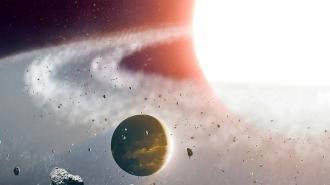Astronomers have discovered a “forbidden planet” orbiting a red giant star that should have already engulfed and destroyed it.
“This shows that planets seem to exist almost anywhere they can exist,” said Jim Fuller, a theoretical astrophysicist at Caltech and co-author of a new study on the strange planet.
Stellar life: Most stars are fueled by the fusion of hydrogen atoms at their cores. As they age, they run out of those atoms and their cores start to collapse. At that point, hydrogen atoms in the plasma that surrounded the core will start to undergo fusion.
That causes the star to expand until it is hundreds of times larger than it was originally. At that point, the star is a red giant. When it completely runs out of hydrogen, it will begin to fuse helium, start shedding its outer layers, and shrink into an ultra-compact white dwarf.
The forbidden planet: A star’s expansion into a red giant can destroy any planets close to it in the solar system — our own sun is expected to engulf Mercury, Venus, and maybe the Earth when it becomes a red giant about 6 billion years from now.
That’s what makes 8 UMi b — a gas giant planet also known as “Halla” — so strange.
“This planet should not exist today!”
Marc Hon
In 2015, Halla was discovered orbiting a red giant star named 8 UMi, also called “Baekdu,” about 520 light-years from Earth. More recent observations revealed that Baekdu is already burning helium and has shrunk to about one-fifteenth of its expected peak size.
That means it should have expanded well beyond Halla’s orbit, engulfing the planet, when it was a full-sized red giant. Yet the planet is still peacefully orbiting the star.
“This is the first system that we know of in which a planet survives so closely around a star burning helium in its core,” Marc Hon, an astronomer at the University of Hawaiʻi, who led the follow-up observations, told Space.com.
“[W]e have here essentially a ‘forbidden planet,’ namely one that has seemingly survived imminent destruction from its once expanding host star,” he added. “In other words, this planet should not exist today!”
What’s going on? Hon and an international team of colleagues recently published a study focused on Halla, and they have two theories as to how the planet managed to escape what should have been certain death.
One is that Baekdu used to be two stars — one a white dwarf and the other a red giant — and Halla orbited them both, like the planet Tatooine in Star Wars. The two stars then merged before the red giant fully expanded.
“Normal stars must expand many times their size before igniting their helium,” said study co-author Nicholas Rui from Caltech. “However, in this case, the extra helium that a red giant gains by swallowing its neighbor star allows it to begin burning helium without having to grow very much.”
“That may have allowed Halla to survive unscathed,” he continued. “If this is true, the discovery shows not only that planets can exist around pairs of stars but that they can continue to survive when those stars violently merge together.”
Another theory is that Halla formed from the debris created when the two stars merged to form Baekdu, meaning it’s a baby planet orbiting an elderly star.
Looking ahead: The researchers plan to continue studying Halla to try to unravel the mystery of how it managed to cheat death, while also scouring the sky for other planets like it.
“There aren’t that many of these stars that have been searched simply because they shouldn’t have planets,” said Hon. “We want to know if there are more of these ‘engulfment-escaping’ surviving planets.”
We’d love to hear from you! If you have a comment about this article or if you have a tip for a future Freethink story, please email us at [email protected].




